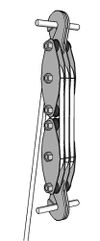Block and Tackle: Difference between revisions
From DT Online
(Created Block and Tackle) |
mNo edit summary |
||
| Line 1: | Line 1: | ||
[[File:BlockTackle.jpg|right|100px]] | [[File:BlockTackle.jpg|right|100px]] | ||
A [https://en.wikipedia.org/wiki/Block_and_tackle '''Block and Tackle'''] comprises a number of pulleys grouped together in blocks or ‘sheaves’ such that one block is fixed and the other is made moveable by means of a single continuous rope, or similar, threaded around them. In this configuration, the load is shared between the number of ropes threaded between the two blocks. | A [https://en.wikipedia.org/wiki/Block_and_tackle '''Block and Tackle'''] comprises a number of pulleys grouped together in blocks or '''''‘sheaves’''''' such that one block is fixed and the other is made moveable by means of a single continuous rope, or similar, threaded around them. In this configuration, the load is shared between the number of ropes threaded between the two blocks. | ||
In the Block and Tackle shown there appears to be 3 ropes on each side joining the two blocks together and so its '''Mechanical Advantage''' would be 6 - i.e. pulling down on the rope with a force of 100kg would enable a load of 600kg to be lifted ''(assuming there are no losses due to friction)''. | In the Block and Tackle shown there appears to be 3 ropes on each side joining the two blocks together and so its '''[[Mechanical Advantage]]''' would be 6 - i.e. pulling down on the rope with a force of 100kg would enable a load of 600kg to be lifted ''(assuming there are no losses due to friction)''. | ||
Revision as of 16:01, 18 February 2015
A Block and Tackle comprises a number of pulleys grouped together in blocks or ‘sheaves’ such that one block is fixed and the other is made moveable by means of a single continuous rope, or similar, threaded around them. In this configuration, the load is shared between the number of ropes threaded between the two blocks.
In the Block and Tackle shown there appears to be 3 ropes on each side joining the two blocks together and so its Mechanical Advantage would be 6 - i.e. pulling down on the rope with a force of 100kg would enable a load of 600kg to be lifted (assuming there are no losses due to friction).
